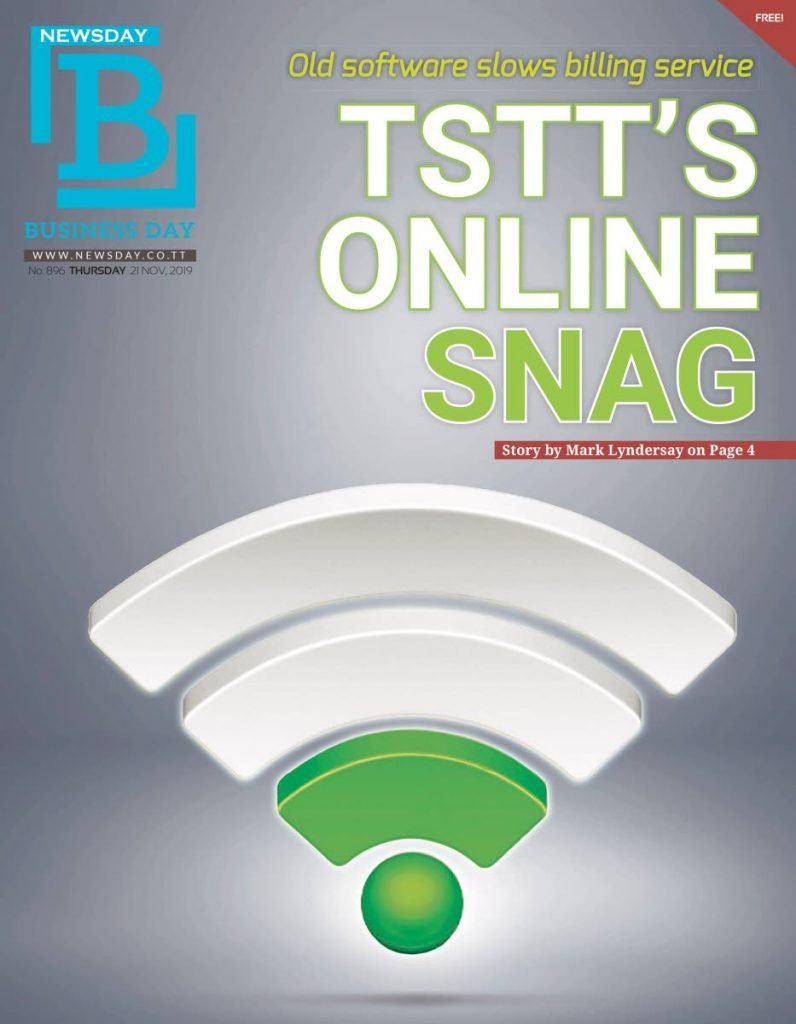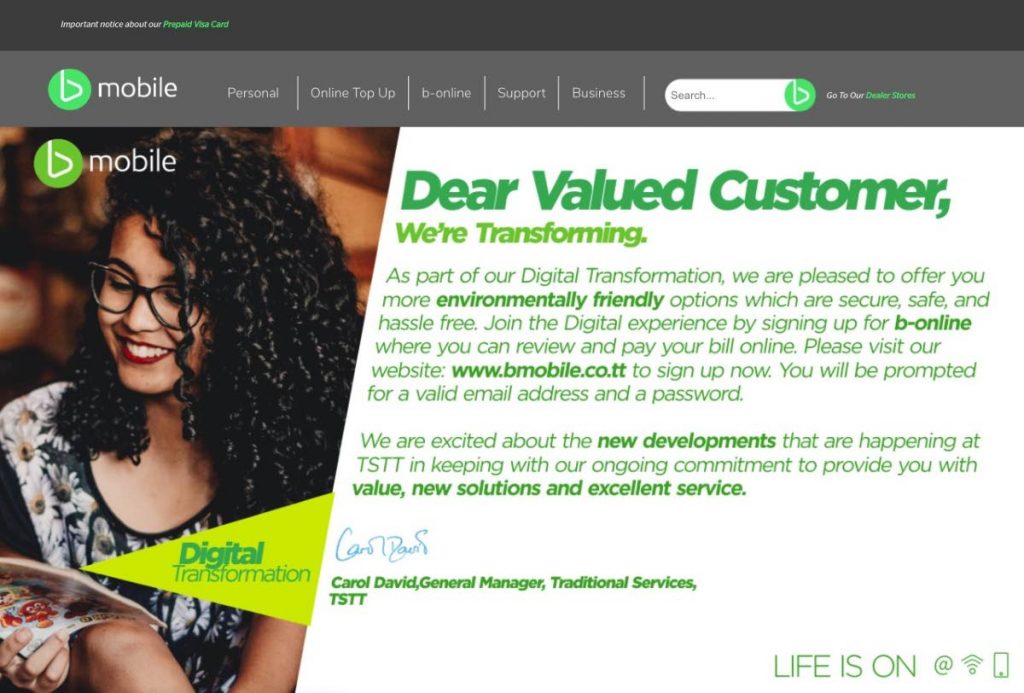Tracking TSTT billing online

The problem
Six months ago, I began to notice a persistent lag in the online updates for the three separately billed services I contracted from TSTT.
In addition, payments weren't being credited to my accounts promptly.
A call to the company's telephone help desk offered one solution. Send an email with scanned or screen-captured proof of payment to an email address created by TSTT to address the problem.
I'd do this every month, though in at least one month my mobile phone service was almost disconnected and I began to wonder if the email service itself was swamped.
Conversations with other customers using online billing suggested that the problem was far more widespread than I'd imagined.
As of this writing, two of my three accounts, both using legacy copper lines that date back more than 20 years, have not been updated online since July.
TSTT has vigorously encouraged its users to use its online services for months.
The sources
My sources for the background of TSTT's software back office problems were five people who agreed to answer specific questions anonymously.
Two are current employees who are not authorised to speak with the media and were keen to keep their jobs.
Three were former employees, one of whom left the company nine years ago. All signed non-disclosure agreements on leaving the company.
What was surprising about all these conversations was a complete absence of rancour. These sources were responding to my questions because they thought the problem had been going on entirely too long.
Instead of annoyance there was frustration about an issue that cut deep into the company and affected almost everyone.
TSTT first received a list of questions about the issues on September 29. I found myself ghosted by the company's communications representative.
The email was not acknowledged, a follow up WhatsApp message went unread.
I resent the message using an unorthodox email I’d sourced to reach the CEO on October 2.
I got an immediate response, followed by a request to wait a bit longer for a response because the company was busy raising funds on a European "roadshow."
Two weeks after the successful investment drive, there was still no response.
I sent the list of questions a third time on November 5, adding additional queries. The company's CTO (chief technology officer), Hassel Bacchus, answered them in face-to-face interview a week ago.
The software
Telecommunications companies have very specific needs for the software that runs their business.
These tools capture information that's critical to billing, ensuring that the lifeblood of the company, cash, is collected, monitored and evaluated to provide the kind of business intelligence that enables competitive strategic growth.
CIS, an acronym for the bluntly named Customer Information System, was an ageing tool in use at TSTT since the 1990s and probably before and it was the model of a vertical market product.
It did everything required to manage the company's business.
It is also partly written in Cobol, an old programming language that became notorious in 1999 for the Y2K bug, a software error that caused uncorrected software to log dates after 1999 as being in 1900.
Even then, as companies raced to fix a problem caused by code written for a much earlier generation of hardware, Cobol programmers were in short supply.
By early 2000 it became clear that CIS had to go.
The software ran on hardware that was no longer made, and the model of telecoms it had been designed to manage, one that assumed a fixed, hardwired network governed by switches, had begun to change.
New products and services simply weren't part of the design of CIS and incrementally TSTT's business migrated to new platforms.
But the company had a goldmine of customer information in CIS, and it began work on moving it to modern systems. TSTT did not disclose the cost of the migration.
In his interview, Bacchus drew two hard lines. The first is 2016, when the company launched a new strategic plan with a mission to become more customer focused.
The other is March 2018, when he was appointed CTO. An edited transcript of the full interview is here:
technewstt.com/bacchus_talks.
The conversation
Bacchus sat for a short Q&A at the company's head office on Brian Lara Promenade, Port of Spain on Wednesday, last week.

PHOTO BY Mark Lyndersay
He fielded questions based on a list of queries I'd sent to the company about its back office operations repeatedly over the last two months.
Did TSTT run a customer management system for more than a decade knowing that it was overdue for upgrade or replacement?
"One of our billing systems, and we have more than one billing system, was CIS, and that is no more. One of the things we had to do was to move from CIS. The solution we were moving to existed before we started to migrate. We’d started to build customers into that (new) solution before. It was in that movement, when we were transferring, that we ran into some issues."
Was CIS written in Cobol?
"Some of it is in Cobol. It is a behemoth. It is a massive system that does almost everything for a company. It handles point of sale, it is a (service) provisioning system, they use a lot of different things to do that. We even had some things written in Basic inside of there. We have people, and we still have people on a consultancy basis, who are expert on it. We brought in international experts as well as people we had here. It’s not like if we weren’t aware of what it was. This is about issues that occur within the hardware and other pieces (and) that meant that we had to change the initial way we were going about it (the migration)."
Is it true that seven years ago a major attempt was made to migrate the system?
"I think you might be referencing a previous attempt at creating a single solution that did all the things (that CIS did). That was only partially successful, and it was also one of the systems that fed information into CIS. That solution from that time is not part of our current operations. This is not a continuation of something that started seven years ago; this is a new effort that came out of our intention to transform the organisation in 2016. There are very few people who have successfully migrated from CIS. Very few."
Were there earlier attempts to migrate from CIS?
"CIS was a solution for everything. Part of the driver for this current dispensation was the clear and present danger that CIS presented was not just that it was old – we had a contract with C&W for its upkeep, so it’s not that it was unsupported – it represented a significant enterprise risk to be running your cash till, your (service) provisioning on this system that is unstable at best and difficult to support even by the people who made it."
What would you have done differently, that the company might have done differently ten years ago?
"If you go back far enough, what you will find is that the way networks were constructed is that the network was the service. In a voice-centric network the switch was the service, and all you do is connect people to it. The service availability was linked to the switch availability. When things started to evolve, I think what people didn’t understand was the decoupling of the service from the network. People were also not looking at the way the new services, broadband type services, were being consumed. That concert of alignment that we have now, I don’t think existed in that detail and was as understood ten years ago. I think, as a result of that (the approach) was a bit more fragmented and it wasn’t focused on the customer."

Was money budgeted for the migration over the last ten years spent on other projects?
"This wasn’t my project for the last ten years. I can speak to the time that I have been CTO. I know that we have spent significant quantities of money on multiple vendors and there has never been a want for funding for the achievement of this goal. It sits squarely as part of the foundation of the strategic plan. It is one of the main strategic initiatives. Other things can suffer, not this."
When did the company leave CIS behind?
"We stopped billing people on CIS as far back as June. As it stands now, CIS has absolutely no function within the organisation as of a few months ago. But CIS is not billing alone, and everything had to be migrated. I think that is probably where the customer felt it most. I’ve heard stories of people going into stores, and they can’t find their accounts. The challenge was making sure that everything that we wanted to have available on the new solutions was there. That has been the gap that we have been faced with from a customer perspective. The majority of those things are behind us now, and by the middle of next month all our accounts will be working as they should as well as the new functionality that we are building into it."
Who should customers talk to if they are not finding their information?
"Our primary interface from a walk-in perspective is the dealer stores and they have significant backline support. Our contact numbers remain the same, and our call centre is mandated to follow up on all queries. If you are unable to get the support you need from a dealer store, contact us directly."


Comments
"Tracking TSTT billing online"